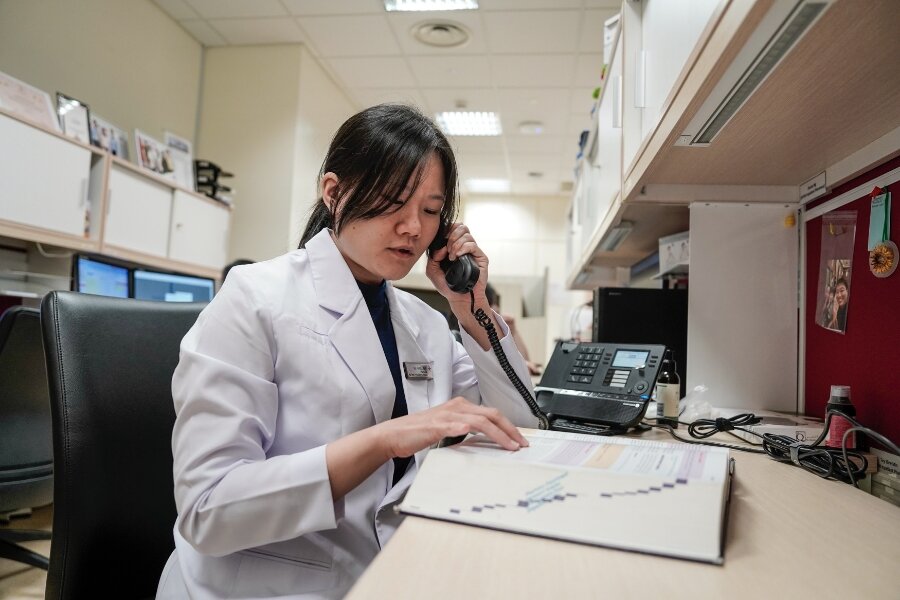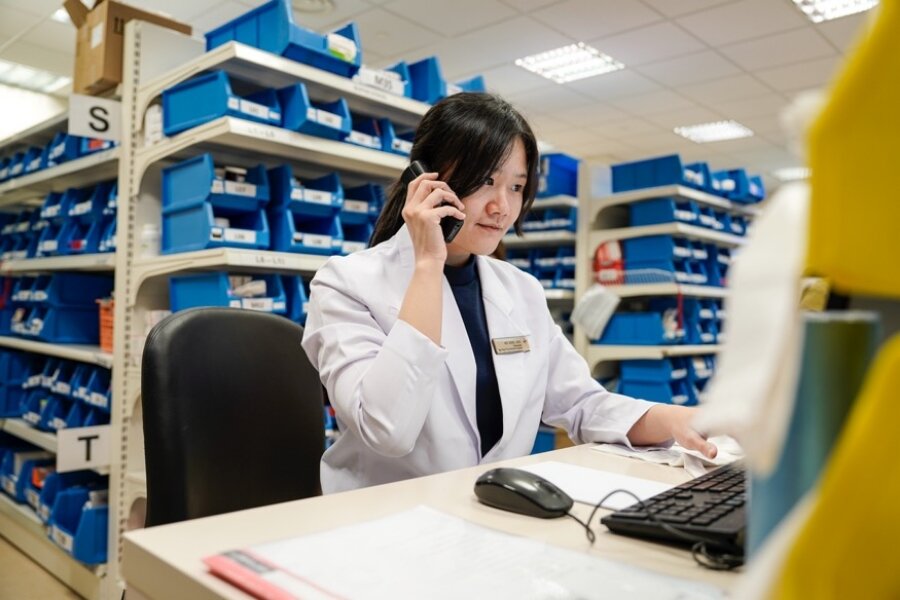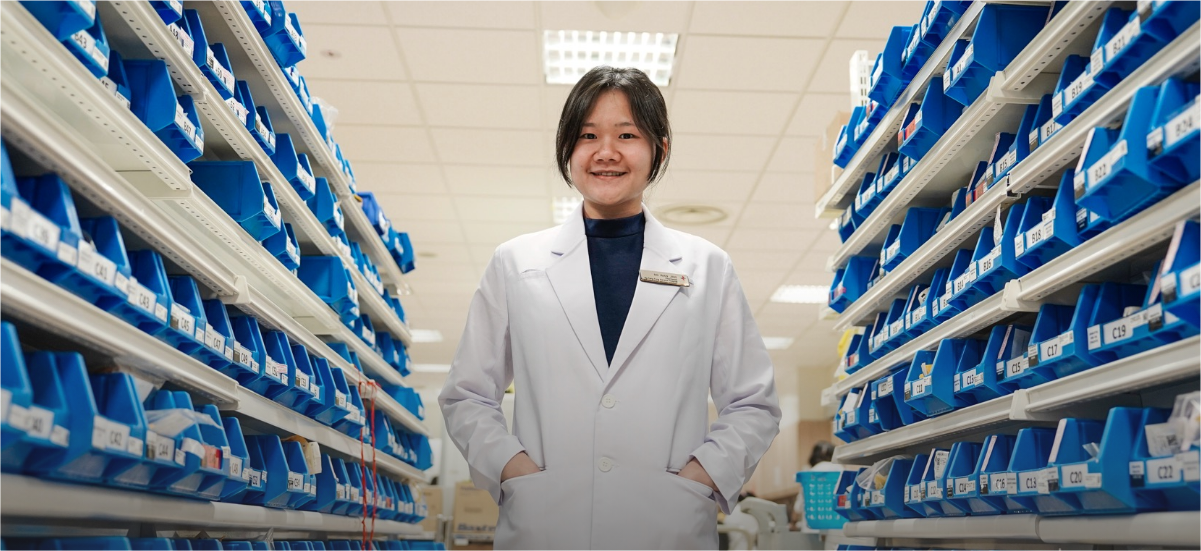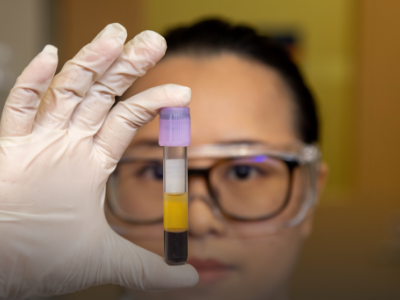Published on 4 January 2024
How a pharmacist helps to boost patient outcomes by thoroughly reviewing their medications and helping patients to manage their treatment.
You might expect a patient with a broken leg from a car accident to be immediately wheeled to surgery, but without thorough medical reconciliation, the lack of crucial details about the medications they are taking may affect treatment plans.

Senior Pharmacist Ms Ng Wan Jing conducts medical reconciliation at Ng Teng Fong General Hospital.
“With prompt and accurate medical reconciliation, we might discover that the patient is, for example, on a very strong blood thinner and not suitable to undergo immediate surgery,” said Ms Ng Wan Jing, Senior Pharmacist at Ng Teng Fong General Hospital (NTFGH).
“So, if the surgery can be delayed without causing much harm, doctors would typically err on the safe side and choose to postpone in, especially after weighing it against the possibility of a catastrophic bleed,” she added.
In the above mentioned scenario, medication reconciliation — which is a structured and explicit process of creating the most accurate list possible of all medications a patient is taking, with the goal of ensuring accurate and complete medication information transfer during care transitions — would have a positive influence on the patient's treatment plan.
The next appropriate steps would be to get the patient started on various medications as part of the treatment plan. Again, any newly introduced medication must not interact or counteract with the patient's usual medication, as it could potentially lead to other complications," explained Ms Ng.

Conducting medical reconciliation requires Ms Ng to tap on extensive research.
The 31-year-old said the study of pharmacy (medication) empowers her with the knowledge to help others. She was drawn to the field of work due to her interest in the sciences and was awarded a Healthcare Scholarship by Ministry of Health to study pharmacy.
“I felt the stars aligned and went ahead with this professional degree. Subsequently, my personal mission of wanting to help others has kept me on the frontline of this field,” she shared.
Patient involvement is crucial
In addition to ensuring safe medication usage and the correct treatment direction, medication reconciliation is also crucial in assessing patients' understanding of their medication regimes.
Ms Ng recalled a recent case of a diabetic patient who was admitted to hospital due to low blood sugar levels. While the system suggested compliance with a regular medication regime, she noticed that there had been a switch in the patient’s diabetes treatment plan a few months ago, from consuming tablets to self-administering insulin injections. She also noticed that the patient had previously collected many tablets. Thus, she interviewed him to find out if he was correctly taking his medication.
“To my surprise, not only was he still taking the tablets which should have ceased, he was also injecting the incorrect dose of insulin due to remembering old doses by heart!” recounted Ms Ng. “These issues are often picked up during medication reconciliation. And the solution is to collaborate with the prescribing physician to decide on a less complicated dosing regimen, as well as provide intensive patient education and medication counselling. Good communication with physicians as well as patients is key here,” she added.
Such critical evaluations can help healthcare professionals reach an agreement with patients about their treatment, thereby optimising clinical outcomes, preventing medication related problems and minimising waste.
Technology helps, but the human touch is still important
According to Ms Ng, tracing patients’ medication history is now much easier, thanks to efforts to unify electronic medical records across Singapore.
She also asserted that digitalisation has helped in the execution of tasks prone to human error, such as manually documenting patients’ medications. The system will alert healthcare professionals to abnormally high dosages, medication combinations with potential negative side effects, and medications that are unsuitable for the patient based on their biodata.
Despite these technological advancements, there is still a need to check with patients and caregivers about their medications, even if they question, “It’s all in the system, why do you have to ask me?”
Ms Ng said, “We might know that the patient is prescribed a tablet to be taken once weekly, but we do not know if they took it yesterday or five days ago.”
With that in mind, medication reconciliation professionals often operate like sleuths, tapping on their experience and knowledge plus observations to identify potential issues. Ms Ng shared that her role requires a considerable amount of soft skills, intuition and cognitive effort. For instance, she may have to contact all the general practitioners in the vicinity of the patient’s home to determine which one they are consulting, as they may not remember. Additionally, she must discern the type of medication a patient is taking by analysing details such as colours and shapes.

Pharmacists are required to make phone calls to find out about patients’ medication history.
“It is easy to find information in the system or on the Internet — we are formally trained in that aspect. It is, however, much more difficult to get information or the ‘truth’ from the patient and/or caregiver because we are dealing with humans who have unique personalities,” shared Ms Ng.
And she has different approaches for this, including looking for non-verbal cues and other clues to arrive at a conclusion. For example, a patient who isn’t being entirely forthcoming about their medication compliance may avoid eye contact or shrug their shoulders. When assessing whether a patient is properly taking their medications, the pharmacist may note if they are able to verbalise their drug dosage and frequency, or indicate the colour of a particular tablet.
“We are not trying to 'reproach' them (for non-compliance) but rather, we need to ensure their safety by knowing what they are actually consuming,” she explained. “Showering them with concern also helps them open up and they will be more likely to divulge the true reason for non-compliance.”
In consultation with Ms Ng Wan Jing, Senior Pharmacist, NTFGH.
Channel your encyclopaedic knowledge towards a force for good. Join us as a pharmacist under our umbrella of Allied Health Professionals.




.png?sfvrsn=8a80b0e7_1)